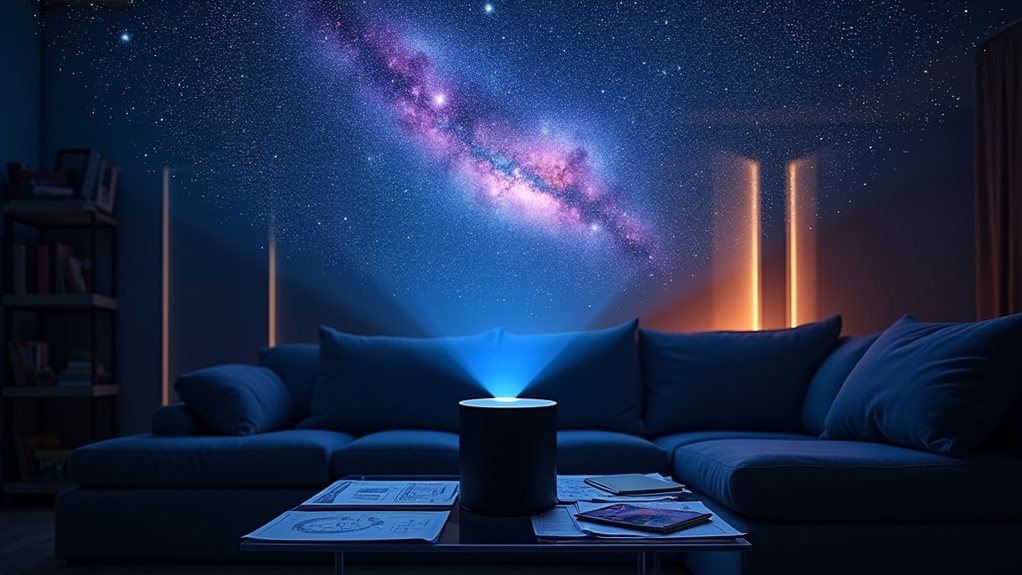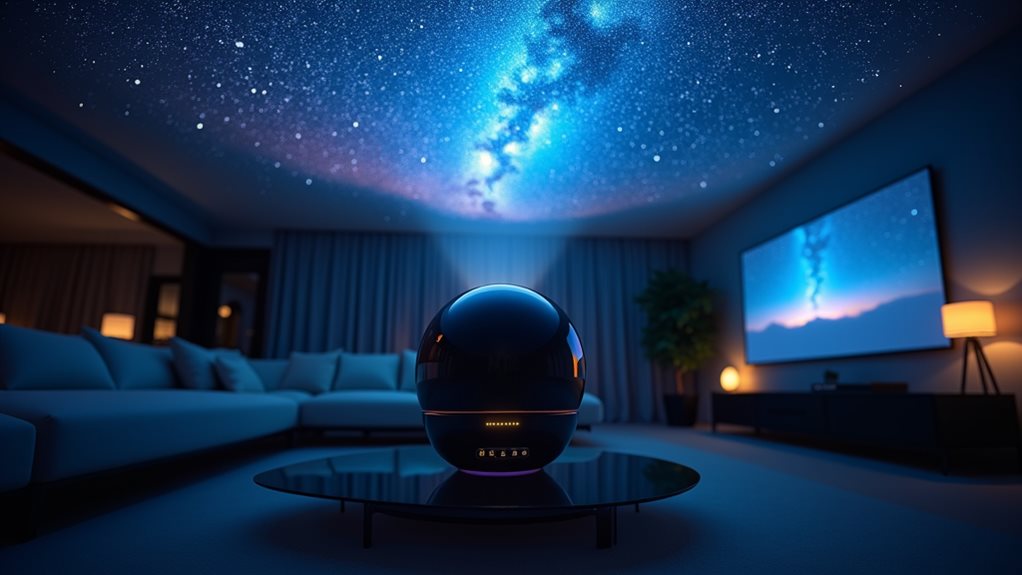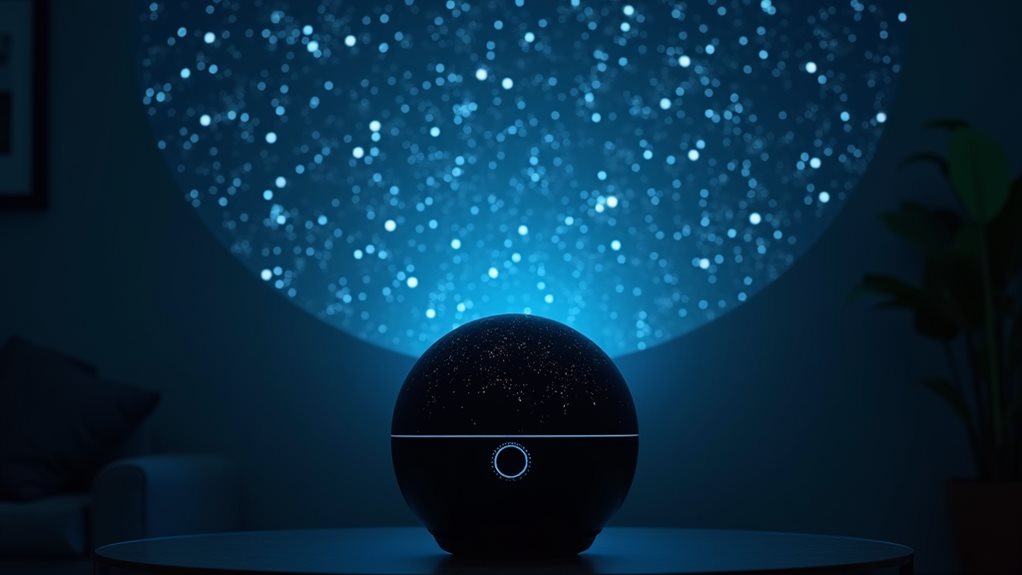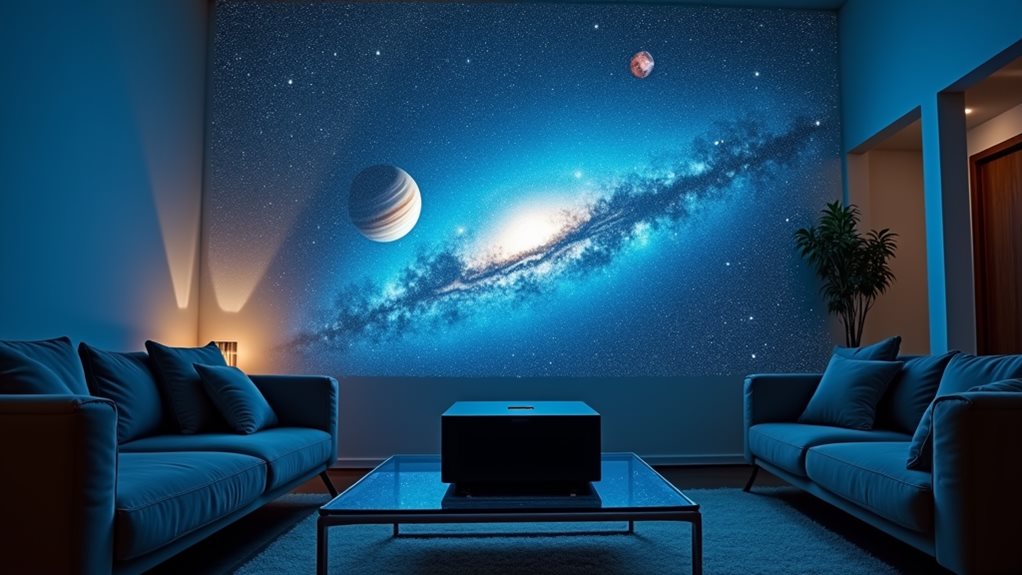When choosing a home planetarium projector, you’ll want to take into account four main types: optical-mechanical, digital, portable, and hybrid models. High-resolution display capabilities, adjustable brightness, and integrated sound systems are essential features for an immersive experience. Top-rated options like the Sega Homestar Flux and Orzorz Galaxy Lite offer impressive star counts and realistic projections. For ideal performance, match your projector to your room’s dimensions and guarantee proper darkness levels. Discover how these celestial displays can transform your space into a personal observatory.
Understanding Home Planetarium Projector Types and Technologies

The fascinating world of home planetarium projectors opens up endless possibilities for stargazing enthusiasts who want to bring the cosmos into their living spaces.
Like the advanced ZEISS fiber optics used in professional planetariums, many home systems now feature sophisticated lighting technology.
When you’re exploring projector comparisons, you’ll discover four main types: optical-mechanical, digital, portable, and hybrid systems, each offering unique advantages for your celestial journey. Digital projectors are particularly popular due to their capability to deliver high-resolution imagery, creating stunning displays.
Thanks to technology advancements, you’ll find sophisticated options like LED-powered systems and fiber optics that create incredibly realistic star displays.
Digital projectors offer versatility with high-resolution imagery and moving visuals, while hybrid models combine the best of both worlds.
These devices are perfect for creating immersive stargazing experiences right in your home.
If you’re seeking flexibility, portable projectors let you share the wonder of the cosmos anywhere.
Modern interactive interfaces make these systems remarkably user-friendly, putting complete control of your personal universe at your fingertips.
Essential Features That Make a Quality Star Projector
When selecting a quality star projector for your home, you’ll need to contemplate several essential features that can greatly impact your celestial viewing experience. The projection quality and adjustable brightness levels will determine how immersive your personal planetarium feels. Modern projectors often include integrated sound systems that enhance the atmospheric experience. For optimal viewing results, complete darkness is necessary in your designated projection space. Additionally, some models provide immersive sound experiences, adding to the overall ambiance.
To guarantee you’re making the right choice, consider these key elements:
- High-resolution display capabilities for crisp star formations
- Multiple projection modes including galaxies and nebulae
- Adjustable focus and rotation settings for ideal viewing
- Smart features with app or remote control functionality
- Built-in timer options to customize your viewing sessions
You’ll want to prioritize models offering versatile power options and mounting capabilities, allowing you to create your perfect stargazing setup anywhere in your home.
Top-Rated Planetarium Projectors Worth Your Investment

Whether you’re a stargazing enthusiast or simply looking to create a magical atmosphere in your home, investing in a high-quality planetarium projector can transform your space into an enchanting cosmic display.
When exploring projector comparisons, you’ll find the Sega Toys Homestar Flux leads the pack with its impressive display of 60,000 stars, though it comes at a premium price. The included detailed sky map helps users identify constellations and celestial bodies with ease, and the brightness feature enhances visibility in dark environments. For optimal viewing results, ensure you have a pitch-black room to experience the full effect of any planetarium projector.
For a balance of quality and value, consider the Orzorz Galaxy Lite, which delivers remarkably realistic starry sky projections and rechargeable convenience.
If you’re working with a tighter budget, the Bresser Junior Astro-Planetarium deluxe offers solid performance with 8,000 celestial bodies.
While the National Geographic Astro Planetarium provides additional multimedia features, you’ll need to weigh whether the compromised projection clarity meets your needs.
Matching Your Space and Needs to the Right Projector
Successfully selecting a home planetarium projector requires careful consideration of your specific environment and intended use.
When matching a projector to your space, you’ll need to evaluate room dimensions and brightness levels to guarantee maximum performance. For superior viewing quality, the Sega Homestar Flux can project stars across distances up to 8.9 feet. The Deep Space Home Planetarium’s rotating main body allows for versatile projection positioning. Additionally, ensuring that your projector choice aligns with your preferred level of realistic star projection can enhance your overall stargazing experience. Don’t let your stargazing dreams be limited by poor planning.
Here’s what you’ll want to assess before making your decision:
- Measure your room’s dimensions and ceiling height to determine ideal projection range
- Consider your room’s ambient light control capabilities
- Evaluate available placement options, whether ceiling-mounted or tabletop
- Check the projector’s brightness adjustment features
- Assess power source locations and accessibility
Setting Up Your Home Planetarium for Optimal Performance

To achieve the stunning celestial display you’ve been dreaming of, proper setup of your home planetarium becomes absolutely essential.
Start with space preparation by creating complete darkness in your viewing room – this isn’t just helpful, it’s critical for the best experience. You’ll want to guarantee your projector alignment is perfect, positioning it on a sturdy base with proper distance from your ceiling. Using a single small light source will ensure the clearest star projections. Additionally, investing in a model with high projection quality will enhance your overall viewing experience.
Taking just two to three minutes for a proper initial setup will maximize your viewing quality.
Don’t overlook the importance of orientation – you’ll need to match compass points with ceiling edges for accurate star positioning.
Consider minimizing reflections with matt black paint, and make sure you’ve got clear floor space around your setup.
If you’ve got a model with rotation features or timing options, take advantage of these to create your own personalized cosmic experience.
Frequently Asked Questions
How Long Do Planetarium Projector Bulbs Typically Last Before Needing Replacement?
You’ll get 2,000-4,000 hours from traditional bulbs, while LED and laser options offer 20,000-50,000 hours of freedom from frequent replacements. Consider upgrading to these longer-lasting options when your bulb’s lifespan ends.
Can Planetarium Projectors Be Used Outdoors for Stargazing Events?
You’ll find most planetarium projectors aren’t suitable for outdoor usage. For stargazing events, you’re better off using telescopes, binoculars, or specialized outdoor planetariums that can handle weather conditions and light pollution.
Do Star Projectors Interfere With Sleep Tracking Devices or Smart Home Sensors?
You won’t need to worry about star projector interference with your sleep tracking devices. Most projectors operate with minimal electromagnetic emissions, and keeping them at a reasonable distance from other electronics guarantees trouble-free operation.
Are Replacement Discs Available for Discontinued Planetarium Projector Models?
You’ll find it challenging to get replacement discs for discontinued models since manufacturers rarely support old units. Your best bet is to choose current models that actively offer disc options for long-term enjoyment.
How Accurate Are Home Planetarium Projectors Compared to Real Astronomical Observations?
While you’ll notice lower visual accuracy in home projectors compared to real stargazing, they can still offer decent astronomical fidelity. You’ll see major constellations and brighter stars, but won’t match observatory-level detail.
Final Thoughts
Now that you’re equipped with extensive knowledge about home planetarium projectors, you’ll be ready to make an informed purchase decision. Remember to prioritize image quality, ease of use, and your specific space requirements when selecting your ideal model. Whether you’re an amateur astronomer or simply love stargazing, your home planetarium projector will transform any room into an enthralling window to the cosmos, bringing the magic of the night sky indoors.

